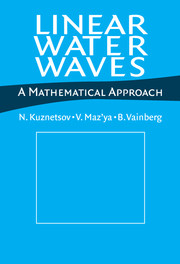Book contents
7 - The Neumann–Kelvin Problem for a Submerged Body
from 2 - Ship Waves on Calm Water
Published online by Cambridge University Press: 14 October 2009
Summary
As for the water-wave problem investigated in Part 1, it is natural to solve the Neumann–Kelvin problem by applying integral equation techniques, since Green's function is constructed. However, in the theory of ship waves this approach is less straightforward than in the theory of time-harmonic waves. First of all, well-posed statements of the two-dimensional Neumann–Kelvin problem are different for totally submerged and surface-piercing bodies because certain supplementary conditions should be imposed in the latter case. Another essential point distinguishes the Neumann–Kelvin problem for a subcritical flow from the water-wave problem. In fact, any solution to the homogeneous water-wave problem has a finite energy, but for solutions of the homogeneous Neumann–Kelvin problem the unconditional validity of this property is still an open question.
So, using integral equations, we have to rely on the method that does not involve an a priori knowledge of uniqueness in the boundary value problem. Such a method was applied to the water-wave problem in Chapters 2 and 3. Its main features are related to the analyticity of integral operators as functions of the parameter ν and to the properties of these operators in limiting cases.
As in Part 1, we treat the simplest problem first, and this is the two-dimensional problem of a body totally submerged in water of infinite depth (see Section 7.1).
- Type
- Chapter
- Information
- Linear Water WavesA Mathematical Approach, pp. 318 - 360Publisher: Cambridge University PressPrint publication year: 2002



